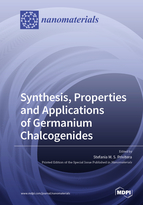Synthesis, Properties and Applications of Germanium Chalcogenides
A special issue of Nanomaterials (ISSN 2079-4991). This special issue belongs to the section "Nanocomposite Materials".
Deadline for manuscript submissions: closed (15 February 2022) | Viewed by 27669
Special Issue Editor
Interests: design, integration and electrical characterization of electronic devices; structural and electrical characterization of materials for advanced data storage, resistive switching memories and phase change materials; solid state phase transitions, induced by laser, electric pulses or ion beam irradiation; development of catalysts for solar fuels
Special Issues, Collections and Topics in MDPI journals
Special Issue Information
Dear colleagues,
Germanium (Ge) chalcogenides are characterized by unique properties which make these materials interesting for a very wide range of applications, from phase change memories to radio frequency (RF) switches and ovonic threshold switches, from photonics to thermoelectric and photovoltaic devices.
By employing electric or laser pulses, Ge chalcogenide materials undergo a large change of the electrical and/or optical properties, enabling their use as storage media, as in phase change optical and electronic memories, or as fast selectors. In many cases the physical properties can be finely tuned by changing the Ge amount, which plays a key role in determining the applications, performance and reliability of the devices.
Ge chalcogenides are also characterized by low lattice thermal conductivity and high point defect concentration, making them also promising candidates for lead-free thermoelectric applications.
This special issue will cover advances in Ge chalcogenides synthesis techniques, including nanostructures and superlattices, in the understanding of the unique properties of Ge chalcogenides, and in devices for optical, electronic and thermoelectric applications.
Dr. Stefania M. S. Privitera
Guest Editor
Manuscript Submission Information
Manuscripts should be submitted online at www.mdpi.com by registering and logging in to this website. Once you are registered, click here to go to the submission form. Manuscripts can be submitted until the deadline. All submissions that pass pre-check are peer-reviewed. Accepted papers will be published continuously in the journal (as soon as accepted) and will be listed together on the special issue website. Research articles, review articles as well as short communications are invited. For planned papers, a title and short abstract (about 100 words) can be sent to the Editorial Office for announcement on this website.
Submitted manuscripts should not have been published previously, nor be under consideration for publication elsewhere (except conference proceedings papers). All manuscripts are thoroughly refereed through a single-blind peer-review process. A guide for authors and other relevant information for submission of manuscripts is available on the Instructions for Authors page. Nanomaterials is an international peer-reviewed open access semimonthly journal published by MDPI.
Please visit the Instructions for Authors page before submitting a manuscript. The Article Processing Charge (APC) for publication in this open access journal is 2900 CHF (Swiss Francs). Submitted papers should be well formatted and use good English. Authors may use MDPI's English editing service prior to publication or during author revisions.
Keywords
- germanium
- phase change materials
- chalcogenide glasses
- Ge chalcogenide nanostructures and superlattices
- ovonic threshold switch
- phase change memories
- RF switches
- thermoelectrics
- chalcogenide metamaterials







